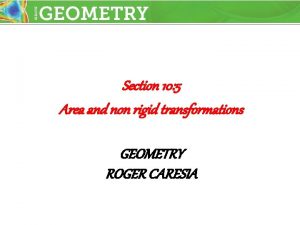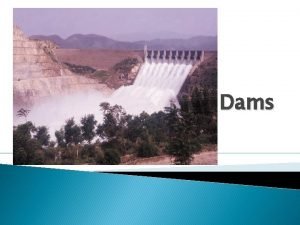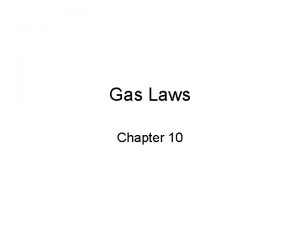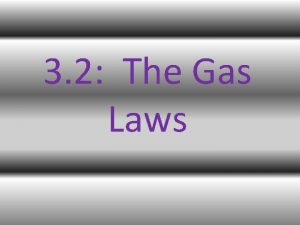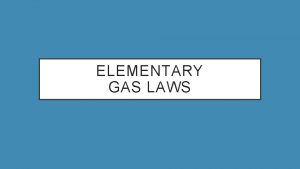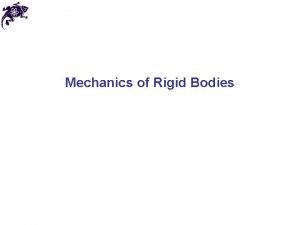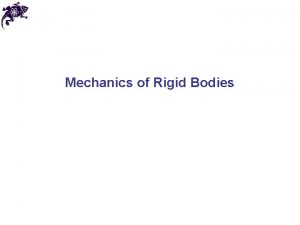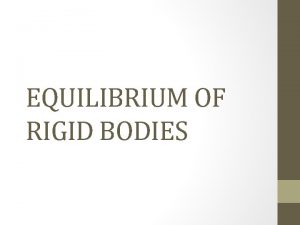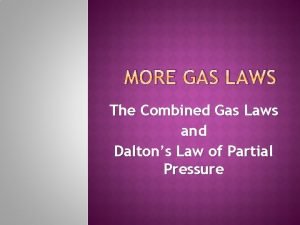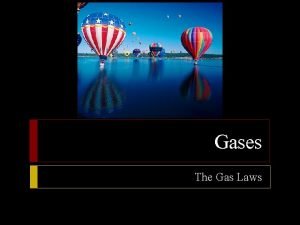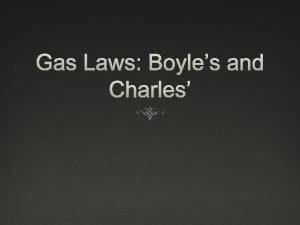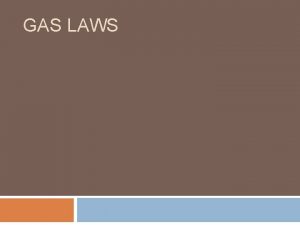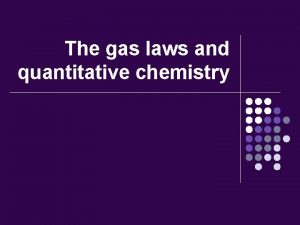Gas Laws Warmup Part Two 1 Which rigid















- Slides: 15

Gas Laws Warmup (Part Two)

1. Which rigid cylinder contains the same number of gas molecules at STP as a 2. 0 -liter rigid cylinder containing H 2(g) at STP? A) 1. 0 -L cylinder of O 2(g) B) 2. 0 -L cylinder of CH 4(g) C) 1. 5 -L cylinder of NH 3(g) D) 4. 0 -L cylinder of He(g)

2. Which statement describes the particles of an ideal gas based on the kinetic molecular theory? A) The gas particles are relatively far apart and have negligible volume. B) The gas particles are in constant, nonlinear motion. C) The gas particles have attractive forces between them. D) The gas particles have collisions without transferring energy.

3. Under which conditions of temperature and pressure would a 1 -liter sample of a real gas behave most like an ideal gas? A) 100 K and 0. 1 atm B) 100 K and 10 atm C) 500 K and 0. 1 atm D) 500 K and 10 atm

4. A rigid cylinder contains a sample of gas at STP. What is the pressure of this gas after the sample is heated to 410 K? A) 1. 0 atm B) 0. 67 atm C) 0. 50 atm C)1. 5 atm

5. According to the kinetic molecular theory, which statement describes the particles in a sample of an ideal gas? A) The force of attraction between the gas particles is strong. B) The motion of the gas particles is random and straight-line. C) The collisions between the gas particles cannot result in a transfer of energy between the particles. D) The separation between the gas particles is smaller than the size of the gas particles themselves.

6. Under which conditions of temperature and pressure would a real gas behave most like an ideal gas? A) 200. K and 50. 0 k. Pa B) 200. K and 200. 0 k. Pa C) 600. K and 50. 0 k. Pa D) 600. K and 200. 0 k. Pa

7. According to the kinetic molecular theory, the molecules of an ideal gas. A) have a strong attraction for each other B) have significant volume C) move in random, constant, straight-line motion D) are closely packed in a regular repeating pattern

8. Under which conditions of temperature and pressure does oxygen gas behave least like an ideal gas? A) low temperature and low pressure B) low temperature and high pressure C) high temperature and low pressure D) high temperature and high pressure

9. A sample of gas occupies a volume of 50. 0 milliliters in a cylinder with a movable piston. The pressure of the sample is 0. 90 atmosphere and the temperature is 298 K. What is the volume of the sample at STP? A) 41 m. L B) 51 m. L C) 49 m. L D) 55 m. L

10. A rigid cylinder with a movable piston contains a 2. 0 -liter sample of neon gas at STP. What is the volume of this sample when its temperature is increased to 30. °C while its pressure is decreased to 90. kilopascals? A) 2. 5 L B) 1. 6 L C) 2. 0 L D) 0. 22 L

11. A sample of gas is held at constant pressure. Increasing the kelvin temperature of this gas sample causes the average kinetic energy of its molecules to A) decrease and the volume of the gas sample to decrease B) decrease and the volume of the gas sample to increase C) increase and the volume of the gas sample to decrease D) increase and the volume of the gas sample to

12. A sample of a gas is contained in a closed rigid cylinder. According to kinetic molecular theory, what occurs when the gas inside the cylinder is heated? A) The number of gas molecules increases. B) The number of collisions between gas molecules per unit time decreases. C) The average velocity of the gas molecules increases. D) The volume of the gas decreases.

13. Under which conditions of temperature and pressure would a sample of H 2(g) behave most like an ideal gas? A) 0°C and 100 k. Pa B) 0°C and 300 k. Pa C) 150°C and 100 k. Pa D) 150°C and 300 k. Pa

14. A sample of oxygen gas is sealed in container X. A sample of hydrogen gas is sealed in container Z. Both samples have the same volume, temperature, and pressure. Which statement is true? A) Container X contains more gas molecules than container Z. B) Container X contains fewer gas molecules than container Z. C) Containers X and Z both contain the same number of gas molecules. D) Containers X and Z both contain the same mass of gas.
